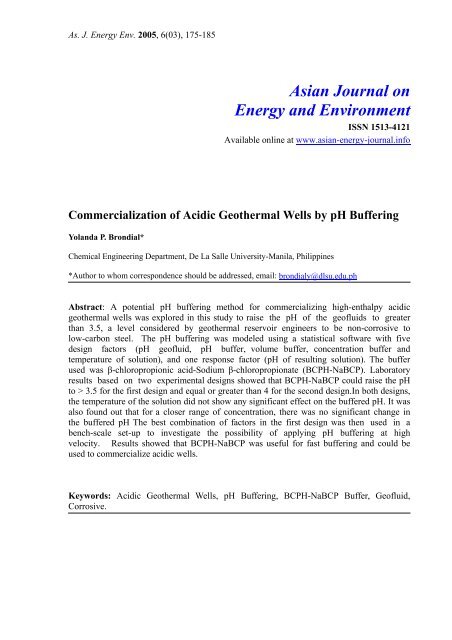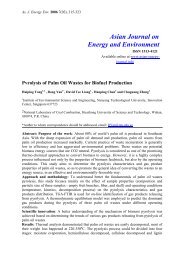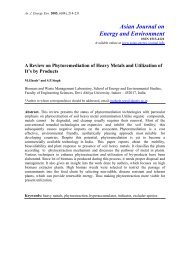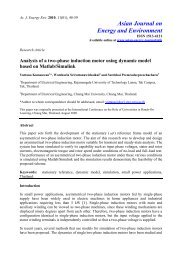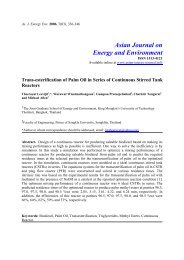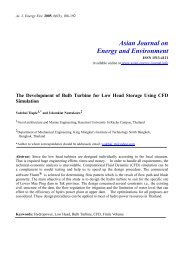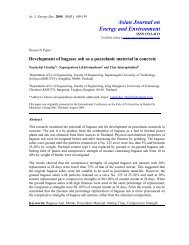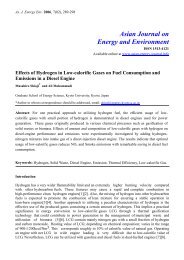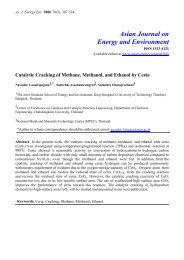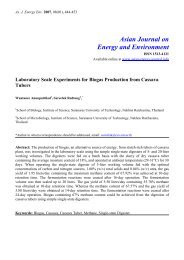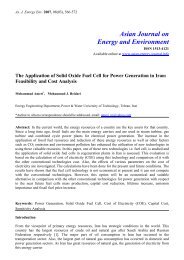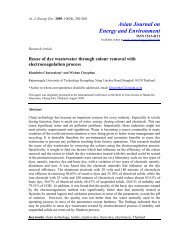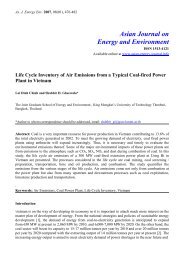Commercialisation of acidic geothermal wells by ph buffering
Commercialisation of acidic geothermal wells by ph buffering
Commercialisation of acidic geothermal wells by ph buffering
Create successful ePaper yourself
Turn your PDF publications into a flip-book with our unique Google optimized e-Paper software.
As. J. Energy Env. 2005, 6(03), 175-185Asian Journal onEnergy and EnvironmentISSN 1513-4121Available online at www.asian-energy-journal.infoCommercialization <strong>of</strong> Acidic Geothermal Wells <strong>by</strong> pH BufferingYolanda P. Brondial*Chemical Engineering Department, De La Salle University-Manila, Philippines*Author to whom correspondence should be addressed, email: brondialy@dlsu.edu.<strong>ph</strong>Abstract: A potential pH <strong>buffering</strong> method for commercializing high-enthalpy <strong>acidic</strong><strong>geothermal</strong> <strong>wells</strong> was explored in this study to raise the pH <strong>of</strong> the ge<strong>of</strong>luids to greaterthan 3.5, a level considered <strong>by</strong> <strong>geothermal</strong> reservoir engineers to be non-corrosive tolow-carbon steel. The pH <strong>buffering</strong> was modeled using a statistical s<strong>of</strong>tware with fivedesign factors (pH ge<strong>of</strong>luid, pH buffer, volume buffer, concentration buffer andtemperature <strong>of</strong> solution), and one response factor (pH <strong>of</strong> resulting solution). The bufferused was β-chloropropionic acid-Sodium β-chloropropionate (BCPH-NaBCP). Laboratoryresults based on two experimental designs showed that BCPH-NaBCP could raise the pHto > 3.5 for the first design and equal or greater than 4 for the second design.In both designs,the temperature <strong>of</strong> the solution did not show any significant effect on the buffered pH. It wasalso found out that for a closer range <strong>of</strong> concentration, there was no significant change inthe buffered pH The best combination <strong>of</strong> factors in the first design was then used in abench-scale set-up to investigate the possibility <strong>of</strong> applying pH <strong>buffering</strong> at highvelocity. Results showed that BCPH-NaBCP was useful for fast <strong>buffering</strong> and could beused to commercialize <strong>acidic</strong> <strong>wells</strong>.Keywords: Acidic Geothermal Wells, pH Buffering, BCPH-NaBCP Buffer, Ge<strong>of</strong>luid,Corrosive.
As. J. Energy Env. 2005, 6(03), 175-185 176IntroductionGeothermal energy is virtually inexhaustible since it draws heat from the earth and itsemission <strong>of</strong> greenhouse gases is minimal compared to fossil fuels.Its potential negativeenvironmental effects are negligible due to the removal <strong>of</strong> hydrogen sulfide fromhigh-temperature steam and the injection <strong>of</strong> spent <strong>geothermal</strong> fluids into the ground.Since the Philippines is part <strong>of</strong> the “Pacific Ring <strong>of</strong> Fire”, it is abundant in <strong>geothermal</strong>energy. It ranks second to the United States in terms <strong>of</strong> installed capacity and third behindMexico in power generation [14]. The country has six <strong>geothermal</strong> power plants: Mak-Ban,Tiwi, Tongonan, Palinpinon, Bac-Man, and Mt. Apo with a generating capacity <strong>of</strong> 1909.23MWe in year 2000.With the implementation <strong>of</strong> the1996-2025 Philippine Energy Plan,<strong>geothermal</strong> power has supplied 22.6% <strong>of</strong> the country's power generation. In spite <strong>of</strong> thehuge available <strong>geothermal</strong> resource in the country, many <strong>of</strong> the <strong>geothermal</strong> <strong>wells</strong> drilledhave produced <strong>acidic</strong> ge<strong>of</strong>luid. These <strong>wells</strong> have high energy content but cannot becommercialized because their ge<strong>of</strong>luid is corrosive to the casing and pipelines <strong>of</strong><strong>geothermal</strong> plants. Of the more than 600 <strong>geothermal</strong> <strong>wells</strong> drilled, 27 <strong>wells</strong> produced<strong>acidic</strong> ge<strong>of</strong>luid with high enthalpy and high wellhead pressure [4]. With the currentpractice <strong>of</strong> plugging and abandoning <strong>acidic</strong> <strong>wells</strong>, the <strong>geothermal</strong> industry incurs a hugefinancial loss [5]. Therefore, it becomes imperative to research and develop methods/techniques to be able to use these <strong>wells</strong> for power generation. Thus, if <strong>acidic</strong> <strong>wells</strong> arecommercialized, drilling and other costs can be recovered, and correspondingly, an increasein energy production can be obtained.Based on the main acid compound controlling its acidity, acid <strong>geothermal</strong> fluids areclassified into hydrochloric acid type [(Cl) - type] which includes Larderello, The Geysers,Kakkonda and Onikobe and the sulfuric acid type [(SO4 ) -2 type] which includesPalinpinon, Bacman, Mt. Apo and Sumikawa [12,16, 19]. The hydrochloric type is due tothe presence <strong>of</strong> Cl - as HCl in superheated steam [9,3,2,6,18] whereas the sulfuric acid typecould be formed <strong>by</strong> oxidation <strong>of</strong> H2S, hydrolysis <strong>of</strong> SO2 or hydrolysis <strong>of</strong> S (native sulfur)[12].Though the corrosive properties <strong>of</strong> these <strong>acidic</strong> fluids limit their utilization for powergeneration, recent successes about new methods <strong>of</strong> treating them <strong>by</strong> raising their pHto a non-corrosive level may bring them back to power lines. At the Onikobe GeothermalPower Plant in Japan, for underground facilities, the internal surface <strong>of</strong> the <strong>acidic</strong> <strong>wells</strong> werecoated with PbS; the production casing from the well mouth to a depth <strong>of</strong> 200 meterswas made <strong>of</strong> CR-25 stainless steel; ceramic plasma was sprayed on the coupling section toprovide insulation between different metals to prevent galvanic corrosion; and a thirdstage casing was inserted for depths from 350 m to 600 m so that if damage occurred on theproduction casing, the double or triple casing would still be present to extend the welllife [1]. At the Coldwater Creek Steam Field and the Aidlin Geothermal Project <strong>of</strong> theGeysers in California which produced <strong>acidic</strong> chloride condensate in the well casings andsteam lines <strong>of</strong> certain fields, a complete treatment was installed utilizing caustic/waterinjection and steam washing as part <strong>of</strong> an over-all corrosion mitigation system [13].At the Miravalles Geothermal Field in Costa Rica, 50% <strong>by</strong> weight sodium hydroxide wasinjected at 950-m depth to neutralize the acid fluid.The developed neutralization systemraised the surface pH values from 2.5 to 6.5 and maintained the pH range stable over the testperiod <strong>of</strong> 28 days [15].
As. J. Energy Env. 2005, 6(03), 175-185 177In the Philippines, PNOC had performed a mitigation process for the Mahanagdong AcidicWell at Tongonan, Leyte in 1998 which consisted <strong>of</strong> injecting NaOH solution into thewellbore to neutralize the acidity <strong>of</strong> the well [17,20]. At Tiwi Geothermal Field in Tiwi,Albay, NaOH injection was performed at its Bariis 8 well. The well was then connected tothe Tiwi steam gathering system for three months after which it was stopped because thewell flow decreased slightly. Efforts to pull the injection assembly out <strong>of</strong> the well have beenunsuccessful to date and the commercial mitigation operation had to be stopped for safetyconsiderations [8].Neutralization using NaOH is expensive and at the same time poses a potential health hazardduring the handling <strong>of</strong> the concentrated solution. It also entails wasted cost due to theneutralization <strong>of</strong> the CO2 and H2S even if these two compounds are present in gaseous form.NaOH absorbs CO2 according to the reaction:The resulting Na2CO3 is partially ionized to form (HCO3) - . Since (HCO3) - is a naturalbuffer, the solution has a pH <strong>of</strong> 8-10. However, if an excess amount <strong>of</strong> NaOH is injected,the pH could be higher than 10 and silica scale will precipitate.Similarly, H2S is absorbedin NaOH solution according to the reaction:The two acid forming gases,CO2 and H2S, are responsible for the acidity <strong>of</strong> the brine.Thus,the removal <strong>of</strong> these gases is an added cost that is not essential. For non-corrosive ge<strong>of</strong>luid,these gases are bled <strong>of</strong>f and partly go with the steam sent to the power plant. Aside fromthis loss in income, the two reactions induce also side reactions. For example, the basicity<strong>of</strong> the brine increases the solubility <strong>of</strong> the CO2. The higher the concentration, the moreCaCO3 is precipitated, thus, inducing scaling problem.If the brine is basic due to theaddition <strong>of</strong> NaOH (pH > 10), the following reactions will occur:These reactions create scaling which is a detrimental problem. In the presence <strong>of</strong> a highconcentration <strong>of</strong> electrolyte in a basic solution, such as in the case <strong>of</strong> <strong>geothermal</strong> brinewith excess NaOH, these two precipitates,Ca(OH)2 and CaCO3, are insoluble.Thus,neutralization with NaOH introduces more problem than just protecting the casing and thesteam gathering system from corrosion. These side effects will not likely to occur if theconcentration <strong>of</strong> the Ca ++ in the brine is below its saturation point. Unfortunately, <strong>acidic</strong><strong>wells</strong> are normally high in Ca ++ (>200ppm).Another technique is the injection <strong>of</strong> CO2 orre-injection <strong>of</strong> NCG. This method utilizes the natural <strong>buffering</strong> effect <strong>of</strong> CO2. An excessiveamount <strong>of</strong> CO2 in the brine solution forms HCO3 - instead <strong>of</strong> the CO3 = as illustrated in theequations below.
As. J. Energy Env. 2005, 6(03), 175-185 178The HCO3 - has an equilibrium pH <strong>of</strong> 8-10. This method had been overlooked from atheoretical standpoint. It is true that the injection <strong>of</strong> CO2 or the re-injection <strong>of</strong> NCG adjuststhe ge<strong>of</strong>luid to a more stable non-corrosive pH <strong>of</strong> 8.35. However, when the ge<strong>of</strong>luid isallowed to flow out <strong>of</strong> the well, the pressure drops, and the temperature remains high,resulting in a substantial decrease in the solubility <strong>of</strong> CO2. As the concentration <strong>of</strong> dissolvedCO2 drops, the natural <strong>buffering</strong> effect <strong>of</strong> CO2 is affected; as a result, the natural acidity<strong>of</strong> the ge<strong>of</strong>luid makes this technique futile for adjusting the pH. This method had been triedin the Philippines but was eventually rejected.The technique <strong>of</strong>commercializing <strong>acidic</strong> <strong>wells</strong> through the use <strong>of</strong> acid resistant materials<strong>of</strong> construction for the steam gathering system and well casing would entail high initialfixed cost that is not feasible in third world countries, like the Philippines. This wouldlikewise result in a high cost <strong>of</strong> power conversion <strong>of</strong> <strong>geothermal</strong> energy making it lessfavorable compared to other sources <strong>of</strong> energy.Materials and MethodologiesBuffer and Buffer CapacityA buffer, composed <strong>of</strong> a weak acid and its strong salt with a strong base or a weak base andits strong salt with a weak acid, has the ability to maintain the pH <strong>of</strong> a solution betweennarrow limits [11]. Therefore, a buffered solution will have no appreciable change in its pHupon dilution or addition <strong>of</strong> slight to moderate amounts <strong>of</strong> a strong acid or base. Buffercapacity is a measure <strong>of</strong> the ability <strong>of</strong> the buffer system to neutralize added strong acid orbase without a significant change in pH. The resistance to change in pH <strong>of</strong> a solution isgreatest when [acid] / [salt] =1.Therefore, buffer capacity is a maximum for buffer solutionscontaining equivalent amounts <strong>of</strong> a weak acid and its salt.As the ratio [acid]/[salt] changesfrom unity,either <strong>by</strong> decreasing or increasing the acid concentration or the salt concentration,the buffer capacity changes.A solution is generally considered to have a useful buffercapacity if the[acid] to [salt] ratio is within the range from 0.1 to 10;hence, effective withinthe range pK a ± 1 [11].New Buffering SolutionThe new buffer used in this investigation is ß - chloropropionic acid- sodium - ß-chloropropionate (BCPH- NaBCP) with a pKa = 4.11 [10] and a boiling point <strong>of</strong> 205 o C[7]. It has a high decomposition point in water (>200) via hydrolysis (Merck Index, 1989).This buffer system was chosen because the designed pH is within 4.11 ± 1 which is theeffective buffer range [11] and will not react with ge<strong>of</strong>luid components.For more than three years now, an extensive study <strong>of</strong> applying pH <strong>buffering</strong> to solvecorrosion and silica-scaling problems encountered in <strong>geothermal</strong> systems [21] has beenconducted.Cabigon had successfully tested this method in the laboratory for silicadissolution without affecting low carbon steel casing.
As. J. Energy Env. 2005, 6(03), 175-185 179MethodologyLaboratory TestsUsing the response surface method with em<strong>ph</strong>asis on central composite design, five factorswere included in each <strong>of</strong> the two experimental designs as shown in the table above. Thefactors were held at specified levels, classified as controllable, while the temperature <strong>of</strong>the resulting solution was allowed to vary in design I but not in design II. The responsevariable employed was the resulting pH <strong>of</strong> solution. After entering all the factors to beconsidered and the response to be obtained <strong>by</strong> experimentation, a tabular form with a total<strong>of</strong> 50 experiments at different combinations <strong>of</strong> factors was generated for each design. Theresponse (pH <strong>of</strong> solution) was experimentally determined for each combination <strong>of</strong> factors.Since all the <strong>acidic</strong> <strong>wells</strong> are plugged / cemented and abandoned, the ge<strong>of</strong>luid used wasobtained from a <strong>geothermal</strong> well at the MakBan Geothermal Field.It was used to maintainthe original chemical composition <strong>of</strong> thege<strong>of</strong>luid and wasacidified with HCl to simulate<strong>acidic</strong> ge<strong>of</strong>luid.For the laboratory experiments done at room temperature, 750 ml <strong>of</strong> ge<strong>of</strong>luid was placed ina one-liter Erlenmeyer flask and into it were added the required pH, concentration andvolume <strong>of</strong> the BCPH-NaBCP buffer according to the experimental design. The pH <strong>of</strong> theresulting solution was measured with a pH meter. However, for the temperature greater thanthe room temperature, the 750 ml ge<strong>of</strong>luid was placed in a three-necked flask in a reflux setupand was added with the required combination <strong>of</strong> pH, concentration and volume <strong>of</strong> theBCPH-NaBCP buffer. In the reflux set-up, a thermometer was inserted in the first neck; thesecond with an ordinary condenser and the third neck is where the sampling was done.Since the pH meter has a temperature probe, the actual reading in the pH meter was recorded.The tests for the thermal stability <strong>of</strong> the <strong>buffering</strong> strengths <strong>of</strong> BCPH-NaBCP solutions weredone <strong>by</strong> heating the solutions for one hour in sealed glass bulblets at 100 o C, 120 o C, 140 o C,160 o C, 180 o C and 200 o C. Also, in this study, the buffer capacity to an added H2SO4 andthe beta factor <strong>of</strong> the BCPH-NaBCP solution were determined.
As. J. Energy Env. 2005, 6(03), 175-185 180Experiments Using the Bench Scale set-upFor the bench-scale set-up as shown in Figure 1, the <strong>buffering</strong> effectiveness <strong>of</strong> theBCPH-NaBCP solutions was evaluated. Geothermal brine (ge<strong>of</strong>luid) from the brine tank ispumped to the mixing tank where the ge<strong>of</strong>luid is heated with steam coming from the boiler.Then, the heated <strong>geothermal</strong> brine passes through the bottom <strong>of</strong> the 25-ft long, 1.5”diameter column and mixes with BCPH-NaBCP solution pumped from the solutiontank. After two minutes, samples <strong>of</strong> the mixed <strong>geothermal</strong> brine and BCPH-NaBCPsolutions are collected at the five ports starting at the bottom <strong>of</strong> the column and at 5-ftintervals up to the top <strong>of</strong> the column. The same procedure was done using this time the25-ft long, 2.0” diameter column.Discussion <strong>of</strong> ResultsLaboratory TestsIn this research, the laboratory data were processed and the significant factors weredetermined using the statistical analysis s<strong>of</strong>tware for the two designs <strong>of</strong> experiments(DOE). The data was analyzed through gra<strong>ph</strong>s and model adequacy testing and thenvalidation <strong>of</strong> the model using confirmation runs.Table1 shows the significant factors andthe interactions for DOE I and for DOE II in Table 2. For both designs, the temperature isnot a significant factor. This finding is very important because this implies that the bufferedpH is stable at elevated temperatures. This means that hot <strong>acidic</strong> ge<strong>of</strong>luid can be bufferedand this could lead to its commercialization. Furthermore, it was found out in Table 2that for a concentration range <strong>of</strong> 0.2 to 0.5, the concentration is not a significant factor.This implies that a small amount <strong>of</strong> buffer is needed, thus, making the <strong>buffering</strong> techniqueinexpensive and could be commercially viable.
As. J. Energy Env. 2005, 6(03), 175-185 181Results showed that based on a completely randomized blocking experiments, the equationfor the pH <strong>of</strong> solution as obtained from the s<strong>of</strong>tware used for the experimental design I is:
As. J. Energy Env. 2005, 6(03), 175-185 182Figure 2 shows the actual value vs the predicted value <strong>of</strong> the pH <strong>of</strong> the solution using themodel equation for the pH <strong>of</strong> the solution.The gra<strong>ph</strong> shows the closeness in the actual andpredicted values <strong>of</strong> the pH <strong>of</strong> the solutionFor the experimental design II, the pH <strong>of</strong> solution is:Experiments on the capacity <strong>of</strong> BCPH-NaBCP to a change in pH from 4.0 to 3.0 and from4.5 to 3.5 <strong>by</strong> the addition <strong>of</strong> a strong acid showed that the greater is the concentration <strong>of</strong>BCPH-NaBCP, the greater is the capacity <strong>of</strong> the buffer solution. Likewise, experiments onthe Beta factor or Beta value <strong>of</strong> BCPH-NaBCP for a change in pH from 4.0 to 5.0 and a pHfrom 4.5 to 5.5 showed that the Beta factor increases with the concentration <strong>of</strong> the buffersystem for the same pH.Results using the Bench Scale Set-upPredicting the best pH <strong>of</strong> solution using the different combinations <strong>of</strong> parameters through thestatistical analysis s<strong>of</strong>tware was also done in this study to find out the best combination <strong>of</strong>factors to be used in the bench-scale set-up. Due to the high costs <strong>of</strong> chemicals needed, thisprocedure was considered necessary so that lesser number <strong>of</strong> trials could be performed, butstill with the best results. So, the best combination <strong>of</strong> factors which were used for thebench-scale set-up were the following: pH ge<strong>of</strong>luid = 3.0, pH buffer = 4.0 and concentrationbuffer = 0.25M.The pH <strong>of</strong> solution at the different ports, e.g., from the bottom to the top <strong>of</strong> the column whichare5 ft from each other, has values greater than 3.5 (Table 4, Table 5). Hence, the resultsshowed that the buffer system can effectively buffer the ge<strong>of</strong>luid.
As. J. Energy Env. 2005, 6(03), 175-185 183ConclusionsLaboratory TestsThe results <strong>of</strong> the laboratory tests showed that the pH <strong>buffering</strong> technique usingBCPH-NaBCP solutions raised the ge<strong>of</strong>luid pH to as high as 4.086 for the firstexperimental design and for the second, to 4.369. The laboratory tests showed that theinitial pH <strong>of</strong> ge<strong>of</strong>luid, the pH, concentration and volume <strong>of</strong> BCPH-NaBCP solutionssignificantly influenced the pH <strong>of</strong> the final solution.Results showed that the pH adjustmentcould be made using the model equation for the two experimental designs. It was alsoproven that the buffer works at elevated temperatures and that smaller amounts <strong>of</strong> bufferwill bring the desired pH.Bench-Scale Set-upThe results <strong>of</strong> the 1.5-inch diameter column (Table 4) and the 2.0 inch diameter column(Table 5) showed that BCPH-NaBCP buffer system raised the ge<strong>of</strong>luid pH to a valuegreater than 3.5 in all the five ports in each column with an interval <strong>of</strong> 5 ft. Based onthe pH <strong>of</strong> the resulting solution, the diameter <strong>of</strong> the column is immaterial in the <strong>buffering</strong><strong>of</strong> the <strong>acidic</strong> <strong>geothermal</strong> brine because the range <strong>of</strong> values for the 1.5-inch column and the2.0-inch column are almost the same which is equal or greater than a pH <strong>of</strong> 3.5RecommendationsSince this particular research has not been tested in an actual <strong>acidic</strong> <strong>geothermal</strong> well,it is recommended that the most advisable strategy is to introduce the BCPH-NaBCP buffersolution at high concentration to the reservoir and then to shut-in the well for a day or twoto allow the well to heat up and to build up pressure, after which BCPH-NaBCP solution isintroduced using an acid string set at the production well. The acid string is inserted throughthe hole at the top <strong>of</strong> the <strong>geothermal</strong> well assembly to reach a certain level where <strong>acidic</strong>waters enter the <strong>geothermal</strong> well. Let the ge<strong>of</strong>luid flow out <strong>of</strong> the well while simultaneouslyinjecting a regulated amount <strong>of</strong> BCPH-NaBCP.
As. J. Energy Env. 2005, 6(03), 175-185 184AcknowledgementThe author is grateful to the Science Foundation and the University Research Center(URCO) <strong>of</strong> De La Salle University-Manila as well as the Department <strong>of</strong> Science andTechnology (DOST) for the financial support extended to her in this research.References[1] Abe, M. (1993) “Long Term Use <strong>of</strong> Acidic Reservoir at Onikobe Geothermal PowerPlant.”Proceedings <strong>of</strong> the 15 th New Zealand Geothermal Workshop, 1993. pp.5 -10 .[2] Allegrini, G and Benvenuti,G.(1970) “Corrosion Characteristics and Geothermal PowerPlant Protection (Collateral Processes <strong>of</strong> Abrasion, Erosion, Scaling).”and Geothermics,2, Part 1, pp. 865-881.[3] Bell, D., (1989) “ Description <strong>of</strong> an Operational Desuperheating and Chloride ScrubSystem.” Geothermal Resources Council Trans. 13, pp. 303-307.[4] Brondial, Y.P.and Puertollano, A.A.(2000) “pH Buffering for Acidic Geothermal WellsUtilization.” INHENYERIYA, an International Journal <strong>of</strong> Engineering, 1, Book 2[5] Brondial, Y.P. and Puertollano , A.A.(2000) “ pH Buffering Formulations for AcidicGeothermal Wells.” Proceedings <strong>of</strong> the 3 rd Asia Pacific Conference on SustainableEnergy and Environmental Technologies, Hongkong, Dec. 3-6, 2000.[6] D’Amore, F., Truesdell, A.H. and Haizlip, J.R. (1990) “Production <strong>of</strong> HCl <strong>by</strong>MineralReactions in High-Tenperature Geothermal Systems.”Proceedings, 15 th Workshop onGeothermal Reservoir Engineering, Stanford, California.[7] Dean, J. (1999) “Lange’s Handbook <strong>of</strong> Chemistry. ” 15 th edition , McGraw - Hill, Inc.[8] Gardner, A.B., Rivera, N.N., Santos, R.M., Toreja, J.S., Vilaseñor, L.B. and Gallup,D.L. (2001) “Mitigation <strong>of</strong> Corrosion in an Acid Producing Well at Tiwi GeothermalField.” 22 nd Annual PNOC-EDC Geothermal Conference Proceedings, 13-14 March,2001, Makati City, Philippines.[9] Haizlip, J.R. and Truesdell, A.H. (1988) “Hydrogen Chloride in Superheated Steamand Chloride in Deep Brine at The Geysers Geothermal Field.”Proceedings , 13 thWorkshop on Geothermal Reservoir Engineering, Stanford, California, pp. 93-100.[10] Harris, D.C., (1999) “Quantitative Chemical Analysis ”,5 th edition,W.H. Freeman andCompany,New York.[11] Kenner, C.T. and K.W. Busch, (1979 ) “Quantitative Analysis.”Macmillan PublishingCompany, New York.[12] Matsuda, K., Shimada, K.and Kiyota, Y. (2000) “Development <strong>of</strong> Study Methods for
As. J. Energy Env. 2005, 6(03), 175-185 185Clarifying Formation Mechanism and Distribution <strong>of</strong> Acid GeothermalFluid - CaseStudies <strong>of</strong> Geothermal Areas in Kyushu , Japan.”Proceedings , World GeothermalCongress 2000, Kyushu-Tohoku, Japan, May 28-June 10, 2000.[13] Meeker, K.A.and Haizlip, J.R. (1990) “Factors Controlling pH and Optimum CorrosionMitigation in Chloride-Bearing Geothermal Steam at TheGeysers.” GeothermalResources Council TRANSACTIONS, 14, Part II, August, 1990.[14] Quijano, J.L. (1993) “Current State <strong>of</strong> Geothermal Energy in Mexico.” Int. Geoth.Assoc. News.[15] Rivera, E.S., Sequeira, H.G. and Ruiz, O.V. (2000) “Commercial Production <strong>of</strong> AcidWells at the Miravalles Geothermal Field, Costa Rica”. Proceedings <strong>of</strong> the WorldGeothermal Congress 2000, Kyushu-Tohoku, Japan, May 28-June 10, 2000.[16] Salonga, N.D. (1996). “Fluid and mineral equilibria inacid NaCl(+SO4) reservoir: TheCase <strong>of</strong> Sandawa Collapse, Mt. Apo hydrothermal system”. Proc. 17 th Annual PNOCEDC Geothermal Conference, pp.119-129.[17] Sanchez, D.R., Herras, E.B., Siega, F.L., Salonga, N.D., Nogara, J.B. and San, B.G.(2001) “Evaluation <strong>of</strong> NaOH injection into Acid Wells <strong>of</strong> Leyte GeothermalProduction Field and Mindanao I Geothermal Project : The Case <strong>of</strong> MG 9D andKN2DWells.” Proceedings <strong>of</strong> the 22 nd Annual PNOC-EDC Geothermal Conference,13-14 March 2001, Makati City, Philippines.[18] Truesdell, A.H., Haizlip, J.R., Armannsson, H. and D’Amore, F.(1989) “ Origin andTransport <strong>of</strong> Chloride in Superheated Geothermal Steam.” Geothermics , 18, no.½,pp. 295-304.[19] Ueda, A., Kubota, Y., Kato, H., Hatakeyama, K.and Matsubaya,O.(1991). GeochemicalCharacteristics <strong>of</strong> the Sumikawa <strong>geothermal</strong> system, northern, Japan. Geochem.J., 25, pp. 223-244.[20] Villa Jr., R.R., Siega, F.L., Olivar, M.M.M., Salonga, N.D., Ogena, M.S., Garcia ,S.E., Buning, B.C., Lichti,K.A.White, S.P. and Sanada, N.(2000) “ A Demonstration <strong>of</strong>The Feasibility <strong>of</strong> Acid Well Utilization: the Philippines’ Well MG-9D Experience.”21 st Annual PNOC-EDC Geothermal Conference,1-2 March, Phils.[21] Cabigon, N.P.and Aquino, C.G.(2000) “Buffered Mainflush Formulation for SandstoneAcidizing.”Inhenyeriya, Book I, Vol.1


